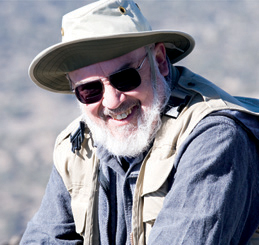Canon EOS 6D
When James (Jim) Johnson retired from a 25-year career as a software developer for IBM, he had already been working as a contract technical editor for Microsoft. After his retirement, technical editing and technical writing became his primary source of income to cover the cost of his toys, most of which were computer equipment and photographic equipment.
Jims involvement with cameras began in the mid 50s when he needed to record the interior of caves in Kentucky. At the time, the greatest challenge was to provide adequate illumination in a manner that did not defile the caves; thus, he purchased a Leica 3F camera (which was then the norm) and experimented with numerous lighting sources. He was later able to add a nice piece of brass-and-glass manufactured by Canon during the post-war occupation. That 100mm telephoto lens was every bit as sharp and capable as the Leica lenses. And so began an appreciation for Japanese camera equipment. There have been numerous Nikon cameras and lenses over the years, but Jims peers are ardent Canon enthusiasts, so he now entertains himself by exploring the latest Canon products.
Jim and his wife Heather live on the California coast, with their home overlooking the Morro Bay estuary. The coast, the bays, and the mountains all combine to host a vast array of botanical subjects which are the focus of Jims current photographic interest.
Canon EOS 6D
The Guide to Understanding and Using Your Camera
Jim Johnson

James Johnson
Editor: Maggie Yates
Copyeditor: Aimee Baldridge
Layout: Petra Strauch
Cover Design: Helmut Kraus, www.exclam.de
Proofreader: Julie Simpson
Printer: Sheridan Books, Inc.
Printed in USA
ISBN 978-1-937538-29-3
1st Edition 2013
2013 by James Johnson
Rocky Nook, Inc.
802 E. Cota Street, 3rd Floor
Santa Barbara, CA 93103
www.rockynook.com
Library of Congress Cataloging-in-Publication Data
Johnson, James, 1935
Canon EOS 6D : the guide to understanding and using your camera / by James Johnson. -- 1st edition.
pages cm
ISBN 978-1-937538-29-3 (softcover : alk. paper)
1. Canon digital cameras--Handbooks, manuals, etc. 2. Single-lens reflex cameras--Handbooks, manuals, etc. 3. Photography--Digital techniques--Handbooks, manuals, etc. I. Title.
TR263.C3J5824 2013
771.3--dc23
2013015489
Distributed by OReilly Media
1005 Gravenstein Highway North
Sebastopol, CA 95472
All rights reserved. No part of the material protected by this copyright notice may be reproduced or utilized in any form, electronic or mechanical, including photocopying, recording, or by any information storage and retrieval system, without written permission of the publisher.
Many of the designations in this book used by manufacturers and sellers to distinguish their products are claimed as trademarks of their respective companies. Where those designations appear in this book, and Rocky Nook was aware of a trademark claim, the designations have been printed in caps or initial caps. All product names and services identified throughout this book are used in editorial fashion only and for the benefit of such companies with no intention of infringement of the trademark. They are not intended to convey endorsement or other affiliation with this book.
While reasonable care has been exercised in the preparation of this book, the publisher and author(s) assume no responsibility for errors or omissions, or for damages resulting from the use of the information contained herein or from the use of the discs or programs that may accompany it.
This book is printed on acid-free paper.
Acknowledgements
A number of people have contributed to the preparation of this book. Very early in the writing, I asked Marlin Harms and Bob Canepa, two published photographers from the California Central Coast, to contribute most of the chapter-opening photos. Bob also provided the books foreword. As always, the staff of Rocky Nook (Joan Dixon, Maggie Yates, Matthias Rossmanith, as well as the technical editors hired for their special areas of expertise) is always helpful and available.
Of course, my most valuable colleague and collaborator is my best friend, Heather, who is also my wife, editor, advisor, and motivator. This book is dedicated to her.
Preface
The Canon EOS (Electro-Optical System) camera was introduced in 1987 with the film-based Canon EOS 650, Canons first auto-focus camera. Though todays Canon SLR cameras are digital, Canons current DSLR system still uses the EOS technology. The acronym EOS was chosen to honor Eos, Greek mythologys Titan goddess of dawn, and is often pronounced as a word, although some spell out the letters, reading it as an initialism.
The Canon EOS 6D is, as of this writing, the smallest, lightest, and least expensive full-frame DSLR that Canon provides. Nonetheless, the 6D comes with a robust set of menus with which you can fine-tune the cameras default settings, customize numerous operational parameters, perform several in-camera editing steps, and initiate specific utilities. The EOS 6D is also Canons first DSLR with built-in GPS and Wi-Fi functions.
The sheer number of features available in the EOS 6D, as well as the numerous menus and controls, tend to overwhelm the minds ability to comprehend, recall, and correctly apply the appropriate settings for achieving the best possible photos. I encourage you to rely on this book, the Instruction Manual, and the cameras built-in Help facilities for assistance with those what-and-how concerns. This will allow your mind to remain alert for photographic opportunities, composition, and exposure.
The Canon EOS 6D is a sophisticated DSLR. It is more capable (and complex) than Canon cameras in the Rebel series, the two-digit D-series, and even the 7D series, but it is certainly not in the same league as the 5D Mark III or the professional 1D cameras. Ive written this book for photographers who are upgrading to the 6D; this text covers the features of the 6D and instructs on implementation and management of those features. Professional photographers who acquire a 6D as a back-up camera for their 1D-series camera or their 5D Mark III will have already mastered most of these techniques and processes.
Some of the features available in the EOS 6D are quite sophisticated; some are so complex that they are difficult to describe in words. For such instances, you may want to access one or more of the online videos or articles that Canon has made available at:
http://www.learn.usa.canon.com/galleries/galleries/tutorials/eos_6d_tutorials.shtml
Though I will mention subjects such as shooting movies and shooting stills with the Scene Intelligent Auto mode, Ive written this book predominantly for an audience of still-photo shooters with skills ranging from those of amateurs with prior DSLR experience to full-time professionals. This book is written with photographers in mind who are comfortable with basic photography, but who need an understanding of the myriad features, functions, options, and settings available with the EOS 6D camera.
I use the model-designations Canon applies to the models sold in the United States. If you have a model intended for a non-US market, it will likely have a different model designation.
Next page



